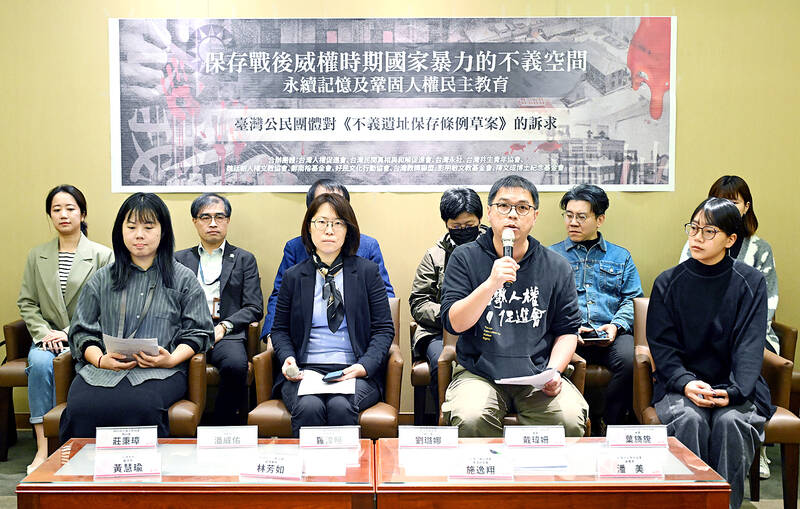The legislature’s Education and Culture Committee yesterday failed to pass a preliminary review of a draft act on the preservation of sites of injustice, as lawmakers could not agree on how to properly address historical sites and historical periods that the draft act would cover.
The National Human Rights Museum’s archive for historical sites of injustice defines “sites of injustice” as those where rulers during the authoritarian era — between Aug. 15, 1945 and Nov. 6, 1992 — contravened human rights by crushing protesters, committing extrajudicial executions, or abusing police or judicial systems to arrest, detain, rape, interrogate, judge, imprison, execute or bury people.
While the Executive Yuan’s version of the draft act adopts the same definition and limits the purview of the bill to sites where injustices were committed between those dates, Chinese Nationalist Party (KMT) Legislator Sra Kacaw and Non-Party Solidarity Union Legislator May Chin (高金素梅) — both representatives of indigenous constituents — proposed that the rulers of the Japanese colonial era between 1895 and 1945, and the Qing Dynasty be included as well.

Photo: Liao Chen-huei, Taipei Times
As lawmakers at the committee failed to reach a consensus on most of the articles, Democratic Progressive Party (DPP) Legislator Fan Yun (范雲), who convened the meeting, ruled to review the draft another time.
Aside from the periods that should be covered in the act, lawmakers also shared different thoughts about whether the sites should be called “sites of injustice” or “human rights historical sites.”
DPP Legislator Lin I-chin (林宜瑾) said that the act should specifically address violence committed by the authoritarian regime against individuals, which should be treated as a separate matter from that committed by colonial regimes.
“Each era has its unique historical background and there should be different remedies for violence in different eras. Including all human rights violations, regardless of the eras in which they happened, would undermine the progress that has already been made in transitional justice. Neither would it help us to deliver a proper review of issues related to state violence,” Lin said.
Sra Kacaw said that indigenous people endured injustices committed by every ruler of Taiwan, and therefore, the act should address all these injustices and all the historical sites related to them.
Groups advocating for transitional justice also criticized the KMT’s version of the act, saying that it was meant to confuse the public about its perception of the authoritarian regime and diminish the brutality of state violence.
“By proposing to expand the time periods covered by the act, is the KMT being serious about addressing issues of transitional justice by tackling its history of ruling through an authoritarian regime? Are they using ‘historical justice’ to confuse the public?” Taiwan Youth Association of Transitional Justice and Kiong-Seng secretary-general Pan Mei (潘美) said.
Pan also urged the legislature to pass the draft act to preserve the sites of injustice.
The National Human Rights Museum has listed 42 confirmed sites of injustice and 64 potential sites of injustice, but the landscape of many of the sites has changed, and the few that remain need urgent repairs, they said.
Without the act, they would not be preserved and might soon be demolished, they added.

An essay competition jointly organized by a local writing society and a publisher affiliated with the Chinese Communist Party (CCP) might have contravened the Act Governing Relations Between the People of the Taiwan Area and the Mainland Area (臺灣地區與大陸地區人民關係條例), the Mainland Affairs Council (MAC) said on Thursday. “In this case, the partner organization is clearly an agency under the CCP’s Fujian Provincial Committee,” MAC Deputy Minister and spokesperson Liang Wen-chieh (梁文傑) said at a news briefing in Taipei. “It also involves bringing Taiwanese students to China with all-expenses-paid arrangements to attend award ceremonies and camps,” Liang said. Those two “characteristics” are typically sufficient

A magnitude 5.9 earthquake that struck about 33km off the coast of Hualien City was the "main shock" in a series of quakes in the area, with aftershocks expected over the next three days, the Central Weather Administration (CWA) said yesterday. Prior to the magnitude 5.9 quake shaking most of Taiwan at 6:53pm yesterday, six other earthquakes stronger than a magnitude of 4, starting with a magnitude 5.5 quake at 6:09pm, occurred in the area. CWA Seismological Center Director Wu Chien-fu (吳健富) confirmed that the quakes were all part of the same series and that the magnitude 5.5 temblor was

The brilliant blue waters, thick foliage and bucolic atmosphere on this seemingly idyllic archipelago deep in the Pacific Ocean belie the key role it now plays in a titanic geopolitical struggle. Palau is again on the front line as China, and the US and its allies prepare their forces in an intensifying contest for control over the Asia-Pacific region. The democratic nation of just 17,000 people hosts US-controlled airstrips and soon-to-be-completed radar installations that the US military describes as “critical” to monitoring vast swathes of water and airspace. It is also a key piece of the second island chain, a string of

The Central Weather Administration has issued a heat alert for southeastern Taiwan, warning of temperatures as high as 36°C today, while alerting some coastal areas of strong winds later in the day. Kaohsiung’s Neimen District (內門) and Pingtung County’s Neipu Township (內埔) are under an orange heat alert, which warns of temperatures as high as 36°C for three consecutive days, the CWA said, citing southwest winds. The heat would also extend to Tainan’s Nansi (楠西) and Yujing (玉井) districts, as well as Pingtung’s Gaoshu (高樹), Yanpu (鹽埔) and Majia (瑪家) townships, it said, forecasting highs of up to 36°C in those areas